brake light TOYOTA SIENNA HYBRID 2022 Owners Manual
[x] Cancel search | Manufacturer: TOYOTA, Model Year: 2022, Model line: SIENNA HYBRID, Model: TOYOTA SIENNA HYBRID 2022Pages: 600, PDF Size: 21.11 MB
Page 3 of 600
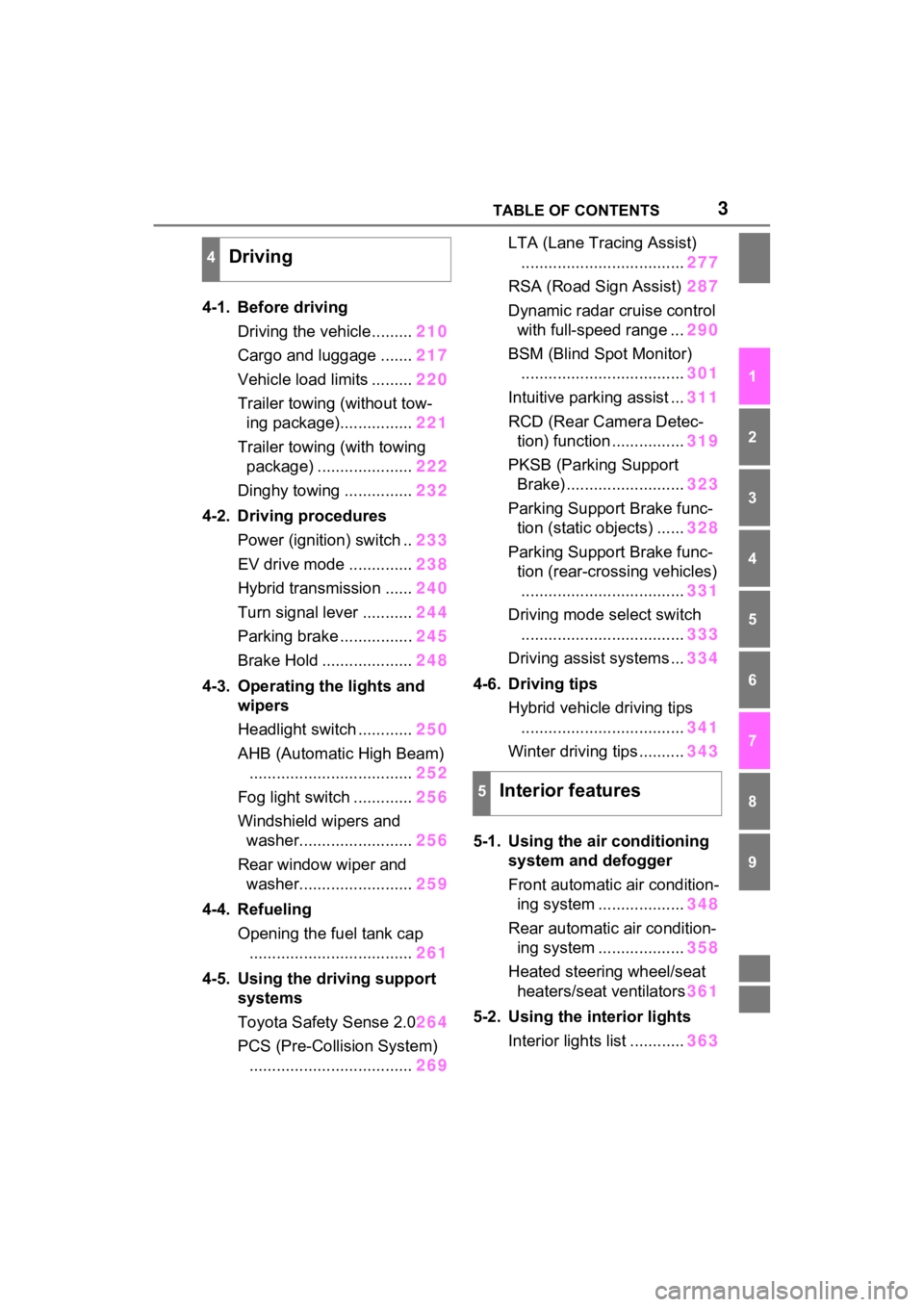
3TABLE OF CONTENTS
1
2
3
4
5
6
7
8
9
4-1. Before drivingDriving the vehicle......... 210
Cargo and luggage ....... 217
Vehicle load limits ......... 220
Trailer towing (without tow- ing package)................ 221
Trailer towing (with towing package) ..................... 222
Dinghy towing ............... 232
4-2. Driving procedures Power (ignition) switch .. 233
EV drive mode .............. 238
Hybrid transmission ...... 240
Turn signal lever ........... 244
Parking brake ................ 245
Brake Hold .................... 248
4-3. Operating the lights and wipers
Headlight switch ............ 250
AHB (Automatic High Beam) .................................... 252
Fog light switch ............. 256
Windshield wipers and washer......................... 256
Rear window wiper and washer......................... 259
4-4. Refueling Opening the fuel tank cap.................................... 261
4-5. Using the driving support
systems
Toyota Safety Sense 2.0 264
PCS (Pre-Collision System) .................................... 269LTA (Lane Tracing Assist)
.................................... 277
RSA (Road Sign Assist) 287
Dynamic radar cruise control with full-speed range ... 290
BSM (Blind Spot Monitor) .................................... 301
Intuitive parking assist ... 311
RCD (Rear Camera Detec- tion) function ................ 319
PKSB (Parking Support Brake) .......................... 323
Parking Support Brake func- tion (static objects) ...... 328
Parking Support Brake func- tion (rear-crossing vehicles).................................... 331
Driving mode s elect switch
.................................... 333
Driving assist systems ... 334
4-6. Driving tips Hybrid vehicle driving tips.................................... 341
Winter driving tips .......... 343
5-1. Using the ai r conditioning
system and defogger
Front automatic air condition- ing system ................... 348
Re ar automatic air condition-
i n
g system ................... 358
Heated steering wheel/seat heaters/seat ventilators 361
5-2. Using the interior lights Interior lights list ............ 363
4Driving
5Interior features
Page 43 of 600
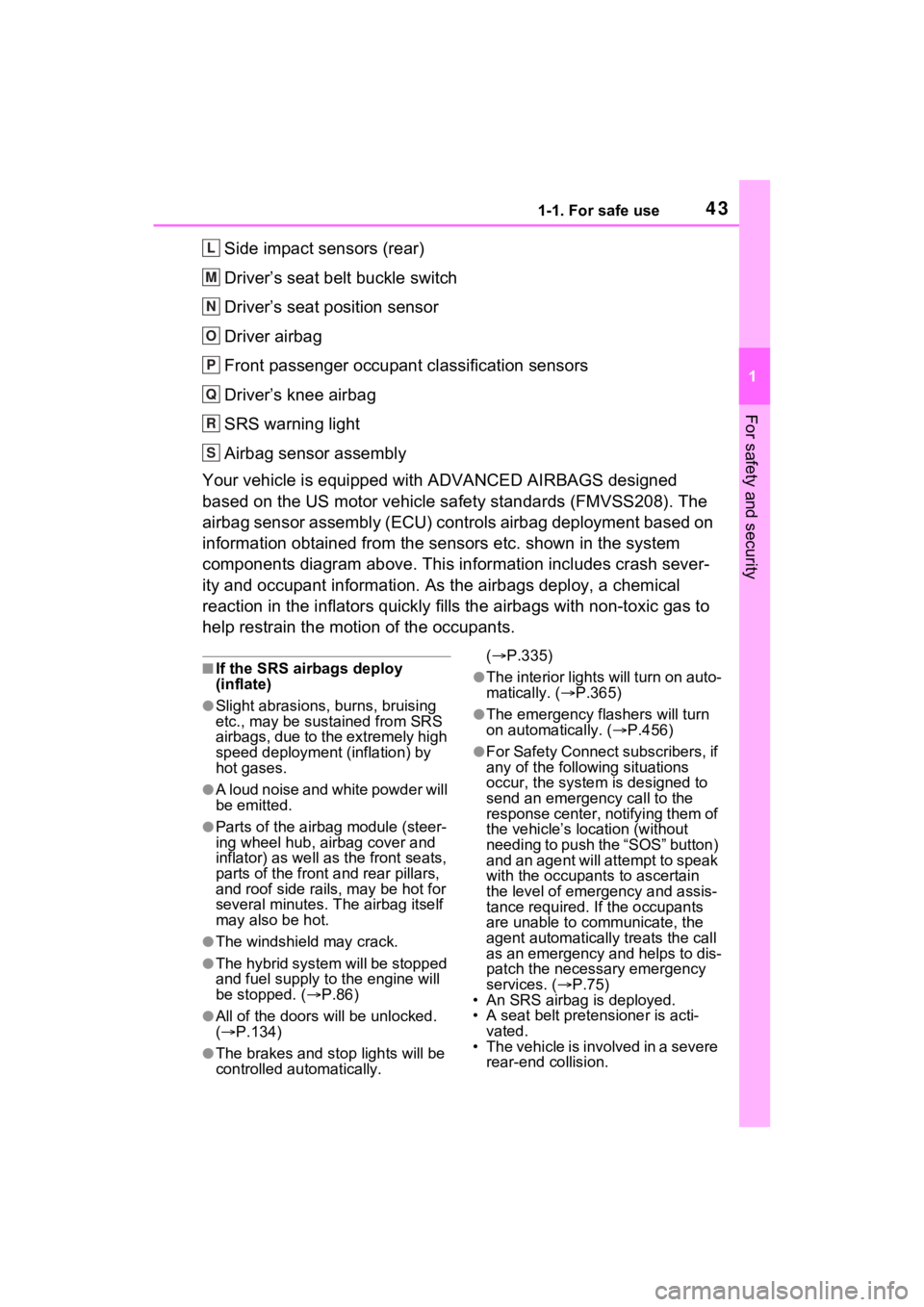
431-1. For safe use
1
For safety and security
Side impact sensors (rear)
Driver’s seat belt buckle switch
Driver’s seat position sensor
Driver airbag
Front passenger occupant classification sensors
Driver’s knee airbag
SRS warning light
Airbag sensor assembly
Your vehicle is equipped with ADVANCED AIRBAGS designed
based on the US motor vehicle safety standards (FMVSS208). The
airbag sensor assembly (ECU) cont rols airbag deployment based on
information obtained from the sensors etc. shown in the system
components diagram above. This in formation includes crash sever-
ity and occupant information. As the airbags deploy, a chemical
reaction in the inflators quickly fills the airbags with non-toxic gas to
help restrain the motion of the occupants.
■If the SRS airbags deploy
(inflate)
●Slight abrasions, burns, bruising
etc., may be sustained from SRS
airbags, due to the extremely high
speed deployment (inflation) by
hot gases.
●A loud noise and white powder will
be emitted.
●Parts of the airbag module (steer-
ing wheel hub, airbag cover and
inflator) as well as the front seats,
parts of the front and rear pillars,
and roof side rails, may be hot for
several minutes. T he airbag itself
may also be hot.
●The windshield may crack.
●The hybrid system will be stopped
and fuel supply to the engine will
be stopped. ( P.86)
●All of the doors will be unlocked.
( P.134)
●The brakes and st op lights will be
controlled automatically. (
P.335)
●The interior lights will turn on auto-
matically. ( P.365)
●The emergency flashers will turn
on automatically. ( P.456)
●For Safety Connect subscribers, if
any of the following situations
occur, the system is designed to
send an emergency call to the
response center, notifying them of
the vehicle’s location (without
needing to push the “SOS” button)
and an agent will attempt to speak
with the occupants to ascertain
the level of emergency and assis-
tance required. If the occupants
are unable to communicate, the
agent automatically treats the call
as an emergency and helps to dis-
patch the necessary emergency
services. ( P.75)
• An SRS airbag is deployed.
• A seat belt pretensioner is acti- vated.
• The vehicle is involved in a severe rear-end collision.
L
M
N
O
P
Q
R
S
Page 84 of 600
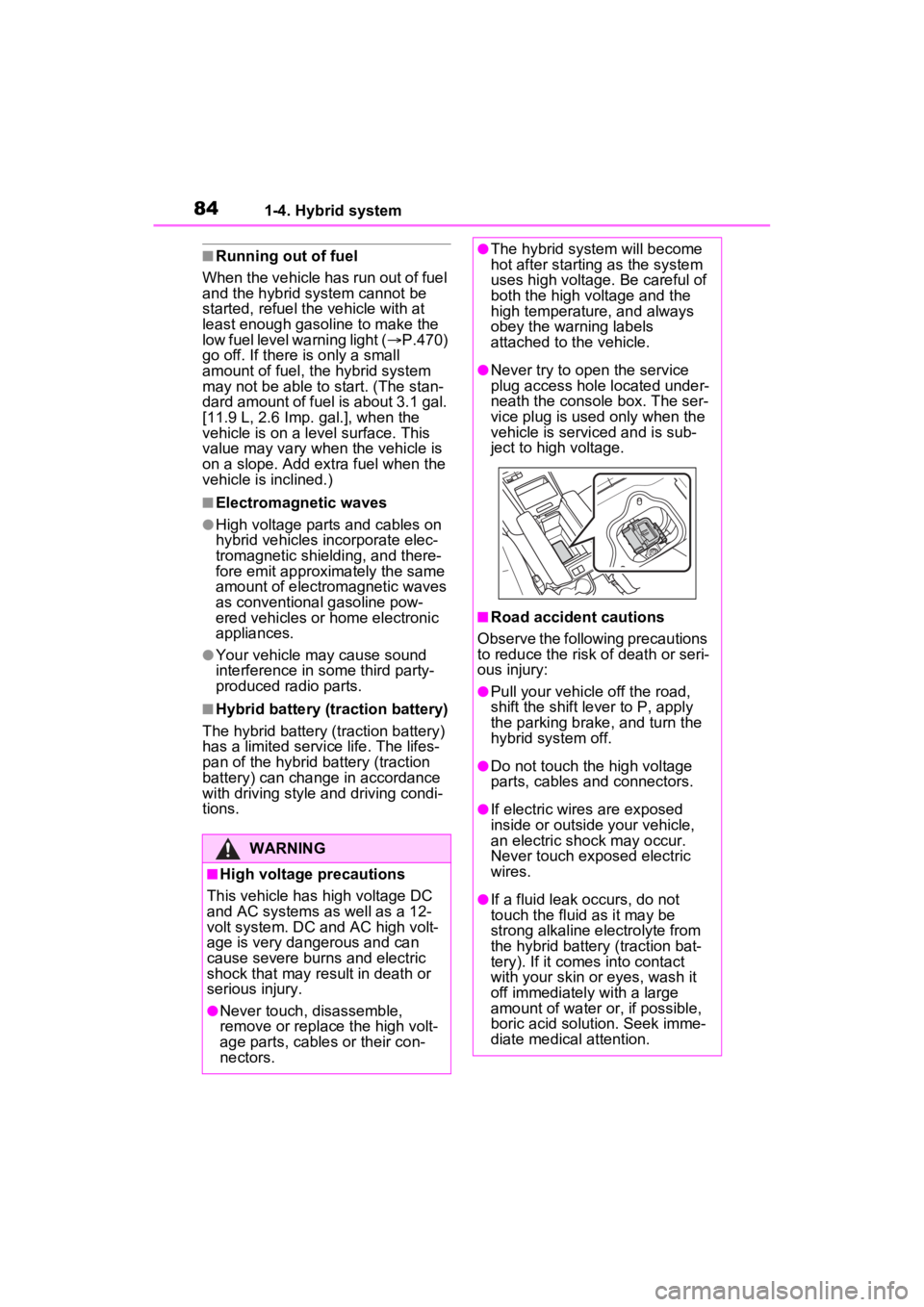
841-4. Hybrid system
■Running out of fuel
When the vehicle has run out of fuel
and the hybrid system cannot be
started, refuel th e vehicle with at
least enough gasoline to make the
low fuel level warning light ( P.470)
go off. If there is only a small
amount of fuel, th e hybrid system
may not be able to start. (The stan-
dard amount of fuel is about 3.1 gal.
[11.9 L, 2.6 Imp. gal.], when the
vehicle is on a level surface. This
value may vary whe n the vehicle is
on a slope. Add ext ra fuel when the
vehicle is inclined.)
■Electromagnetic waves
●High voltage parts and cables on
hybrid vehicles incorporate elec-
tromagnetic shielding, and there-
fore emit approximately the same
amount of electromagnetic waves
as conventional gasoline pow-
ered vehicles or home electronic
appliances.
●Your vehicle may cause sound
interference in so me third party-
produced radio parts.
■Hybrid battery (tr action battery)
The hybrid battery (traction battery)
has a limited service life. The lifes-
pan of the hybrid battery (traction
battery) can change in accordance
with driving style and driving condi-
tions.
WARNING
■High voltage precautions
This vehicle has high voltage DC
and AC systems as well as a 12-
volt system. DC and AC high volt-
age is very dangerous and can
cause severe burns and electric
shock that may result in death or
serious injury.
●Never touch, disassemble,
remove or replace the high volt-
age parts, cables or their con-
nectors.
●The hybrid system will become
hot after starting as the system
uses high voltage. Be careful of
both the high voltage and the
high temperature, and always
obey the warning labels
attached to the vehicle.
●Never try to open the service
plug access hole located under-
neath the console box. The ser-
vice plug is used only when the
vehicle is serviced and is sub-
ject to high voltage.
■Road accident cautions
Observe the following precautions
to reduce the risk of death or seri-
ous injury:
●Pull your vehicle off the road,
shift the shift le ver to P, apply
the parking brake, and turn the
hybrid system off.
●Do not touch the high voltage
parts, cables and connectors.
●If electric wires are exposed
inside or outside your vehicle,
an electric shock may occur.
Never touch exposed electric
wires.
●If a fluid leak occurs, do not
touch the fluid as it may be
strong alkaline electrolyte from
the hybrid battery (traction bat-
tery). If it comes into contact
with your skin or eyes, wash it
off immediately with a large
amount of water or, if possible,
boric acid solution. Seek imme-
diate medical attention.
Page 93 of 600
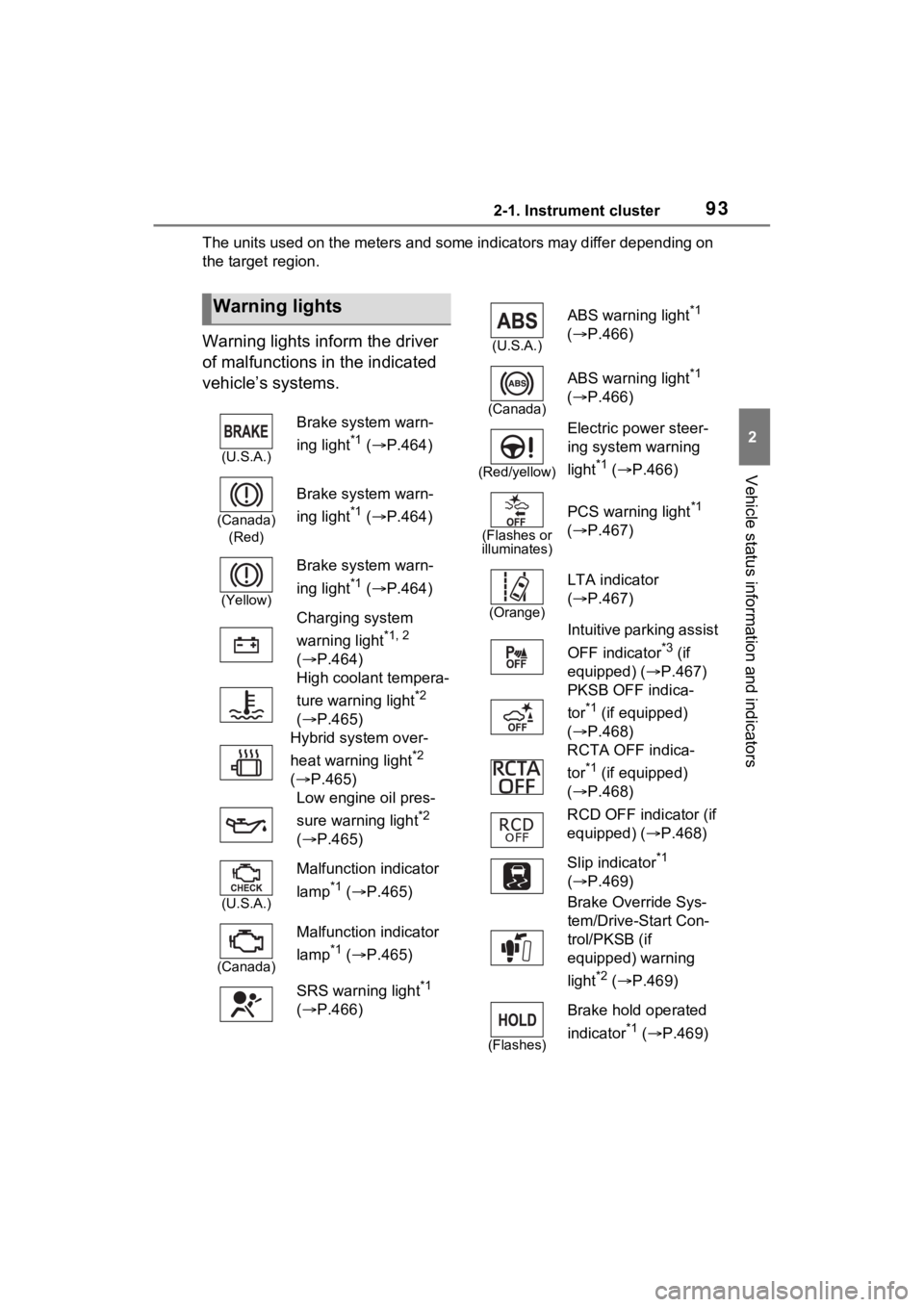
932-1. Instrument cluster
2
Vehicle status information and indicators
The units used on the meters and some indicators may differ depending on
the target region.
Warning lights inform the driver
of malfunctions in the indicated
vehicle’s systems.
Warning lights
(U.S.A.)
Brake system warn-
ing light
*1 ( P.464)
(Canada)
(Red)
Brake system warn-
ing light
*1 ( P.464)
(Yellow)
Brake system warn-
ing light
*1 ( P.464)
Charging system
warning light
*1, 2
( P.464)
High coolant tempera-
ture warning light
*2
( P.465)
Hybrid system over-
heat warning light
*2
( P.465)
Low engine oil pres-
sure warning light
*2
( P.465)
(U.S.A.)
Malfunction indicator
lamp
*1 ( P.465)
(Canada)
Malfunction indicator
lamp
*1 ( P.465)
SRS warning light
*1
( P.466)
(U.S.A.)
ABS warning light*1
( P.466)
(Canada)
ABS warning light*1
( P.466)
(Red/yellow)
Electric power steer-
ing system warning
light
*1 ( P.466)
(Flashes or
illuminates)
PCS warning light*1
( P.467)
(Orange)
LTA indicator
( P.467)
Intuitive parking assist
OFF indicator
*3 (if
equipped) ( P.467)
PKSB OFF indica-
tor
*1 (if equipped)
( P.468)
RCTA OFF indica-
tor
*1 (if equipped)
( P.468)
RCD OFF indicator (if
equipped) ( P.468)
Slip indicator
*1
( P.469)
Brake Override Sys-
tem/Drive-Start Con-
trol/PKSB (if
equipped) warning
light
*2 ( P.469)
(Flashes)
Brake hold operated
indicator
*1 ( P.469)
Page 94 of 600
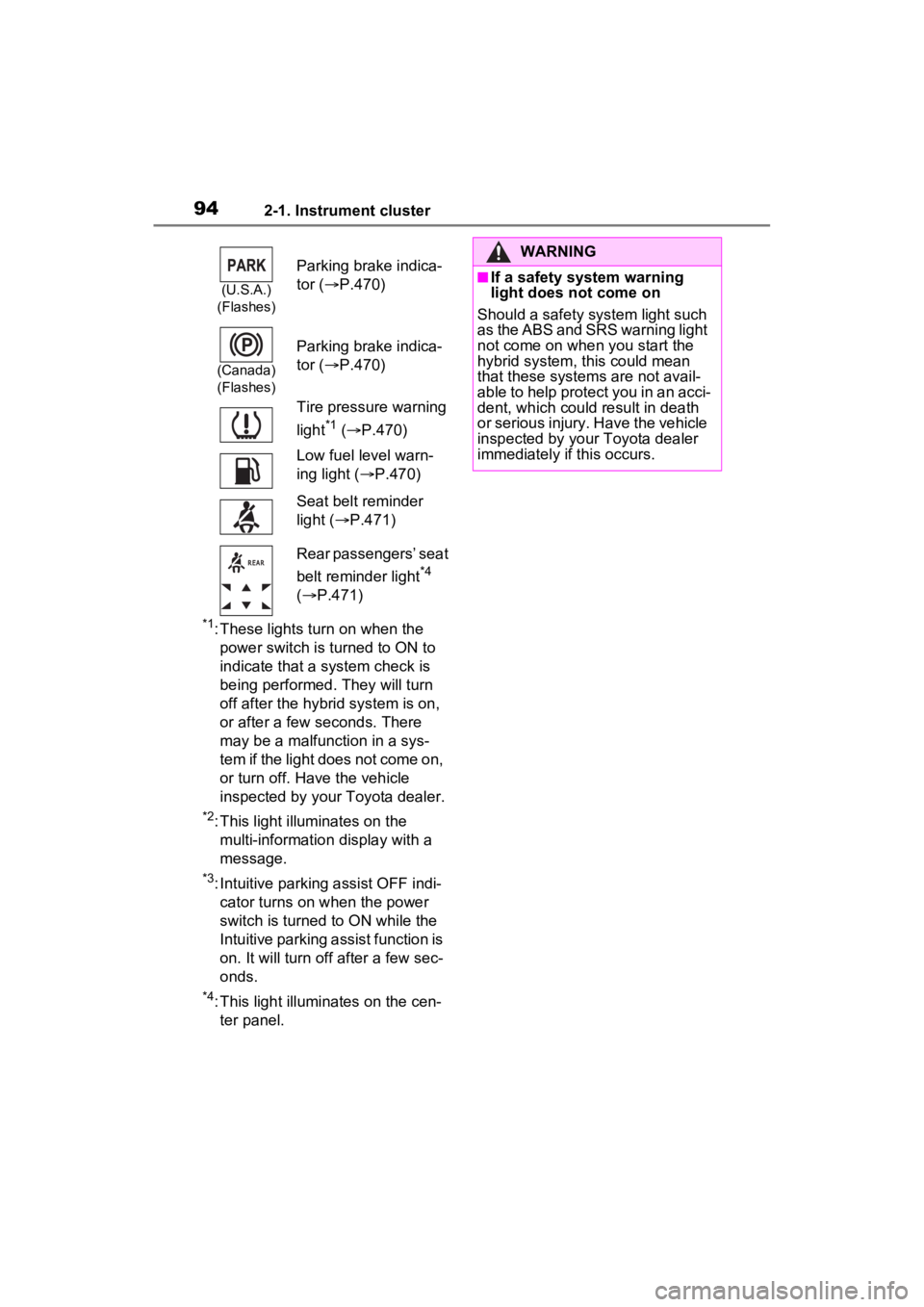
942-1. Instrument cluster
*1: These lights turn on when the power switch is turned to ON to
indicate that a system check is
being performed. They will turn
off after the hybr id system is on,
or after a few seconds. There
may be a malfunction in a sys-
tem if the light does not come on,
or turn off. Have the vehicle
inspected by your Toyota dealer.
*2: This light illuminates on the multi-informatio n display with a
message.
*3: Intuitive parking assist OFF indi- cator turns on when the power
switch is turned to ON while the
Intuitive parking assist function is
on. It will turn off after a few sec-
onds.
*4: This light illumi nates on the cen-
ter panel.
(U.S.A.)
(Flashes)
Parking brake indica-
tor ( P.470)
(Canada)
(Flashes)
Parking brake indica-
tor ( P.470)
Tire pressure warning
light
*1 ( P.470)
Low fuel level warn-
ing light ( P.470)
Seat belt reminder
light ( P.471)
Rear passengers’ seat
belt reminder light
*4
( P.471)
WARNING
■If a safety system warning
light does not come on
Should a safety system light such
as the ABS and SRS warning light
not come on when you start the
hybrid system, this could mean
that these system s are not avail-
able to help protect you in an acci-
dent, which could result in death
or serious injury. Have the vehicle
inspected by your Toyota dealer
immediately if this occurs.
Page 95 of 600
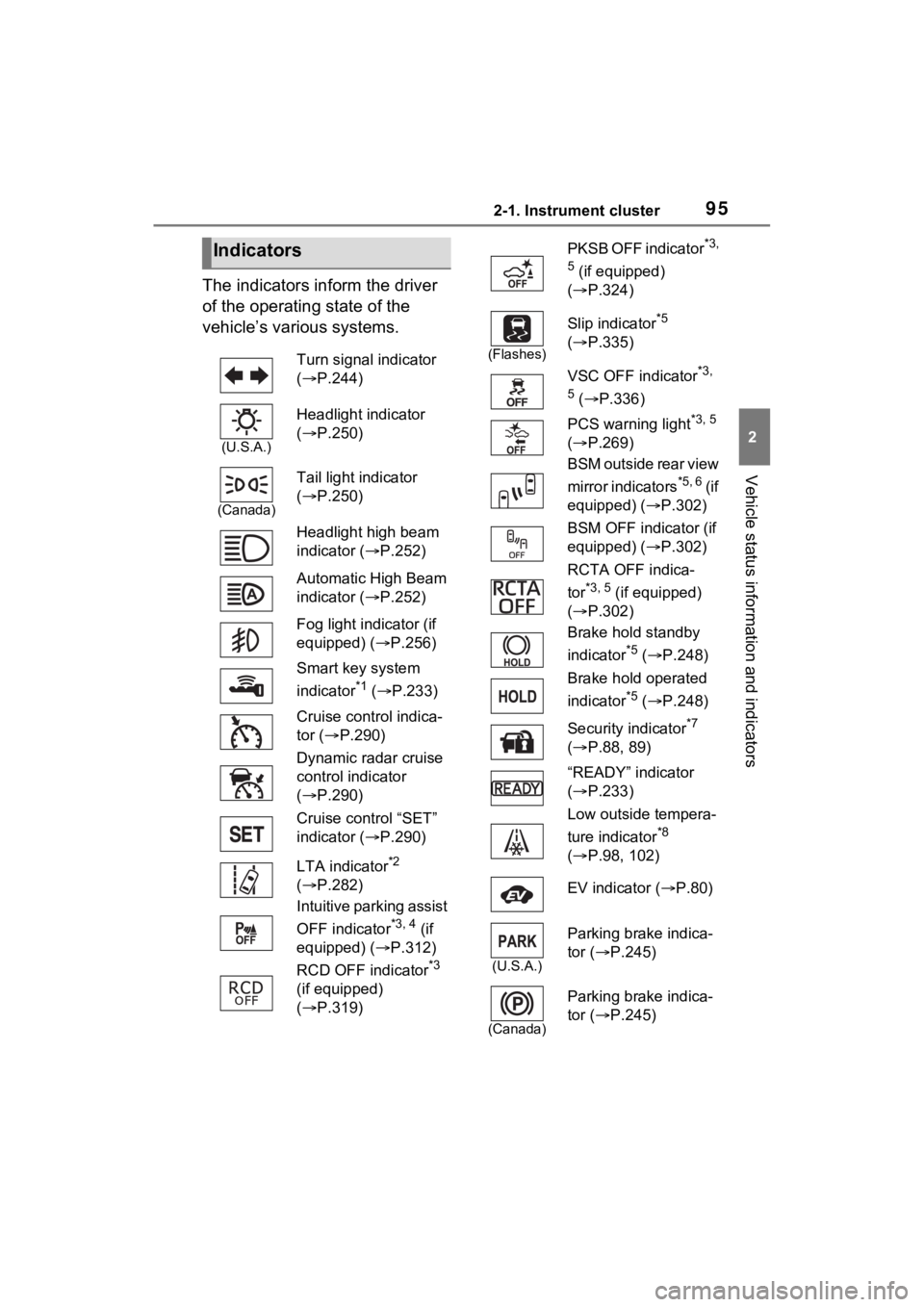
952-1. Instrument cluster
2
Vehicle status information and indicators
The indicators inform the driver
of the operating state of the
vehicle’s various systems.
Indicators
Turn signal indicator
( P.244)
(U.S.A.)
Headlight indicator
( P.250)
(Canada)
Tail light indicator
( P.250)
Headlight high beam
indicator ( P.252)
Automatic High Beam
indicator ( P.252)
Fog light indicator (if
equipped) ( P.256)
Smart key system
indicator
*1 ( P.233)
Cruise control indica-
tor ( P.290)
Dynamic radar cruise
control indicator
( P.290)
Cruise control “SET”
indicator ( P.290)
LTA indicator
*2
( P.282)
Intuitive parking assist
OFF indicator
*3, 4 (if
equipped) ( P.312)
RCD OFF indicator
*3
(if equipped)
( P.319)
PKSB OFF indicator*3,
5
(if equipped)
( P.324)
(Flashes)
Slip indicator*5
( P.335)
VSC OFF indicator
*3,
5
( P.336)
PCS warning light
*3, 5
( P.269)
BSM outside rear view
mirror indicators
*5, 6 ( i f
equipped) ( P.302)
BSM OFF indicator (if
equipped) ( P.302)
RCTA OFF indica-
tor
*3, 5 (if equipped)
( P.302)
Brake hold standby
indicator
*5 ( P.248)
Brake hold operated
indicator
*5 ( P.248)
Security indicator
*7
( P.88, 89)
“READY” indicator
( P.233)
Low outside tempera-
ture indicator
*8
( P.98, 102)
EV indicator ( P.80)
(U.S.A.)
Parking brake indica-
tor ( P.245)
(Canada)
Parking brake indica-
tor (P.245)
Page 144 of 600
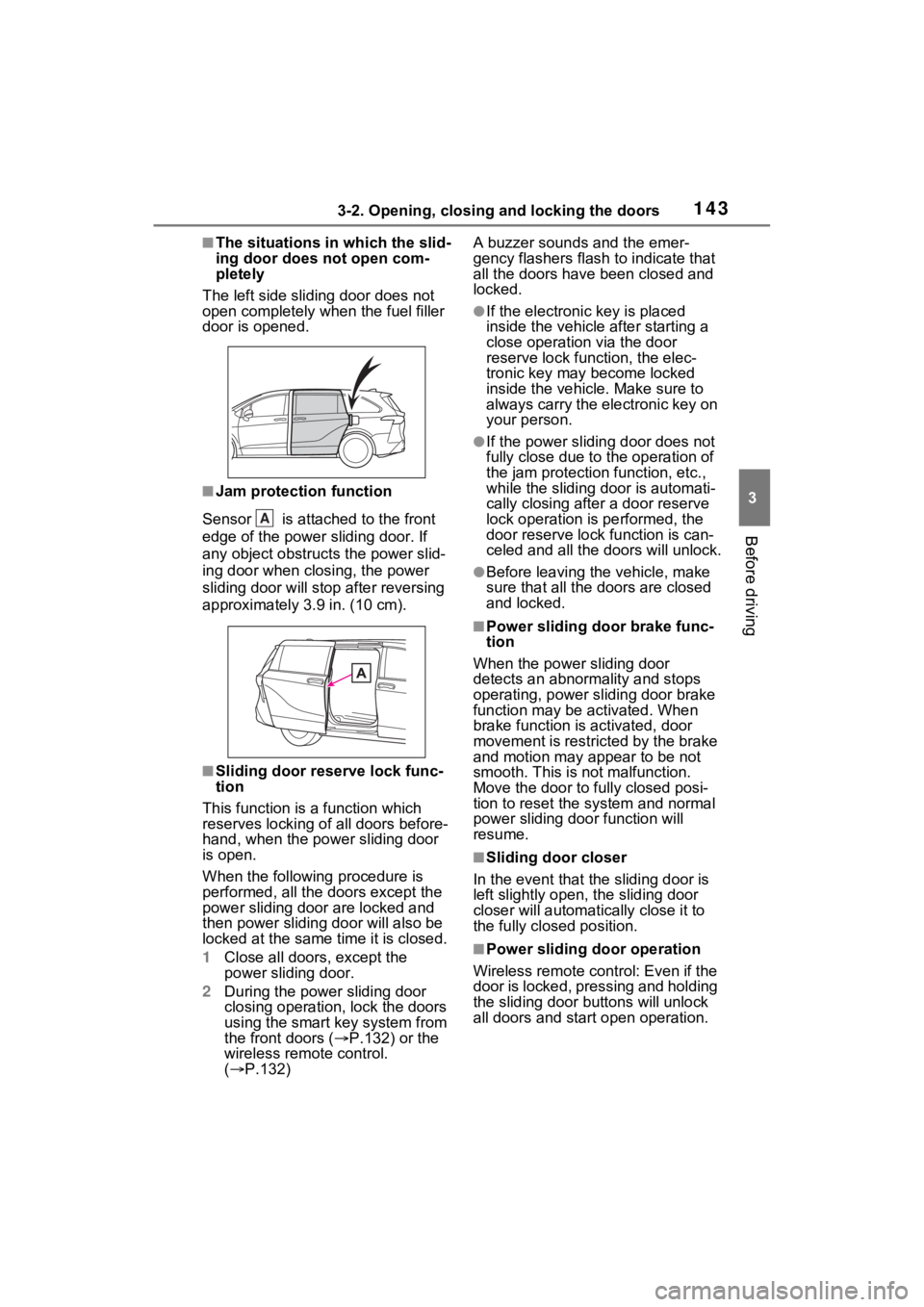
1433-2. Opening, closing and locking the doors
3
Before driving
■The situations in which the slid-
ing door does not open com-
pletely
The left side sliding door does not
open completely when the fuel filler
door is opened.
■Jam protection function
Sensor is attached to the front
edge of the power sliding door. If
any object obstructs the power slid-
ing door when cl osing, the power
sliding door will stop after reversing
approximately 3.9 in. (10 cm).
■Sliding door reserve lock func-
tion
This function is a function which
reserves locking of all doors before-
hand, when the power sliding door
is open.
When the following procedure is
performed, all the doors except the
power sliding door are locked and
then power sliding door will also be
locked at the same time it is closed.
1 Close all doors, except the
power sliding door.
2 During the power sliding door
closing operation, lock the doors
using the smart key system from
the front doors ( P.132) or the
wireless remo te control.
( P.132) A buzzer sounds and the emer-
gency flashers flash to indicate that
all the doors have been closed and
locked.
●If the electronic key is placed
inside the vehicle after starting a
close operation via the door
reserve lock function, the elec-
tronic key may become locked
inside the vehicl
e. Make sure to
always carry the electronic key on
your person.
●If the power sliding door does not
fully close due to the operation of
the jam protection function, etc.,
while the sliding door is automati-
cally closing after a door reserve
lock operation is performed, the
door reserve lock function is can-
celed and all the doors will unlock.
●Before leaving the vehicle, make
sure that all the doors are closed
and locked.
■Power sliding door brake func-
tion
When the power sliding door
detects an abnorma lity and stops
operating, power sliding door brake
function may be activated. When
brake function is activated, door
movement is restricted by the brake
and motion may appear to be not
smooth. This is not malfunction.
Move the door to fully closed posi-
tion to reset the system and normal
power sliding doo r function will
resume.
■Sliding door closer
In the event that the sliding door is
left slightly open, the sliding door
closer will automatically close it to
the fully closed position.
■Power sliding door operation
Wireless remote control: Even if the
door is locked, pressing and holding
the sliding door bu ttons will unlock
all doors and start open operation.
A
Page 210 of 600
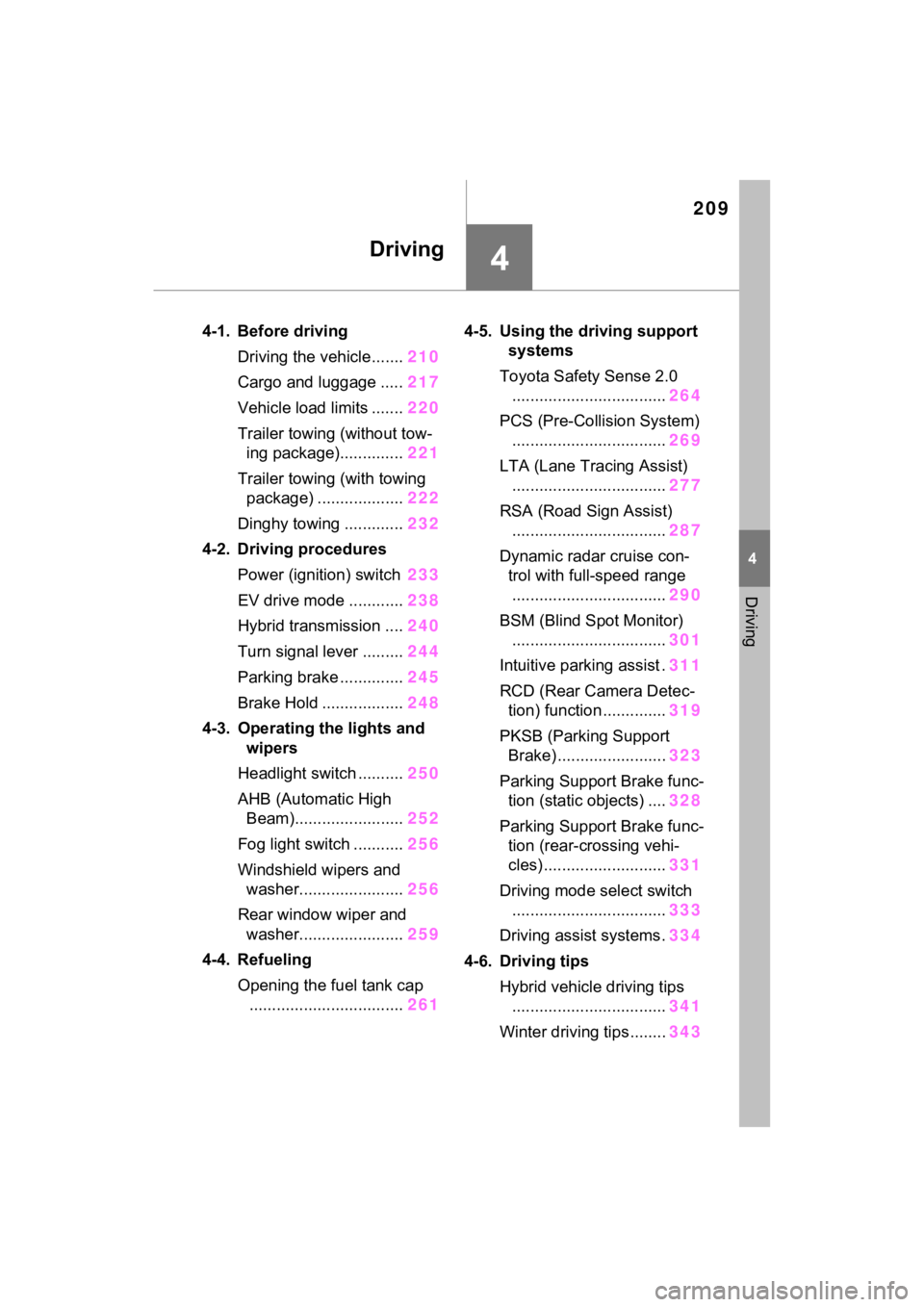
209
4
4
Driving
Driving
4-1. Before drivingDriving the vehicle....... 210
Cargo and luggage ..... 217
Vehicle load limits ....... 220
Trailer towing (without tow- ing package).............. 221
Trailer towing (with towing package) ................... 222
Dinghy towing ............. 232
4-2. Driving procedures Power (ignition) switch 233
EV drive mode ............ 238
Hybrid transmission .... 240
Turn signal lever ......... 244
Parking brake .............. 245
Brake Hold .................. 248
4-3. Operating the lights and wipers
Headlight switch .......... 250
AHB (Automatic High Beam)........................ 252
Fog light switch ........... 256
Windshield wipers and washer....................... 256
Rear window wiper and washer....................... 259
4-4. Refueling Opening the fuel tank cap.................................. 2614-5. Using the dr
iving support
systems
Toyota Safety Sense 2.0 .................................. 264
PCS (Pre-Collision System) .................................. 269
LTA (Lane Tracing Assist) .................................. 277
RSA (Road Sign Assist) .................................. 287
Dynamic radar cruise con- trol with full-speed range
.................................. 290
BSM (Blind Spot Monitor) .................................. 301
Intuitive parking assist . 311
RCD (Rear Camera Detec- tion) function .............. 319
PKSB (Parking Support Brake) ........................ 323
Parking Support Brake func- tion (static objects) .... 328
Parking Support Brake func- tion (rear-crossing vehi-
cles) ........................... 331
Driving mode select switch .................................. 333
Driving assist systems. 334
4-6. Driving tips Hybrid vehicle driving tips.................................. 341
Winter driving tips........ 343
Page 213 of 600
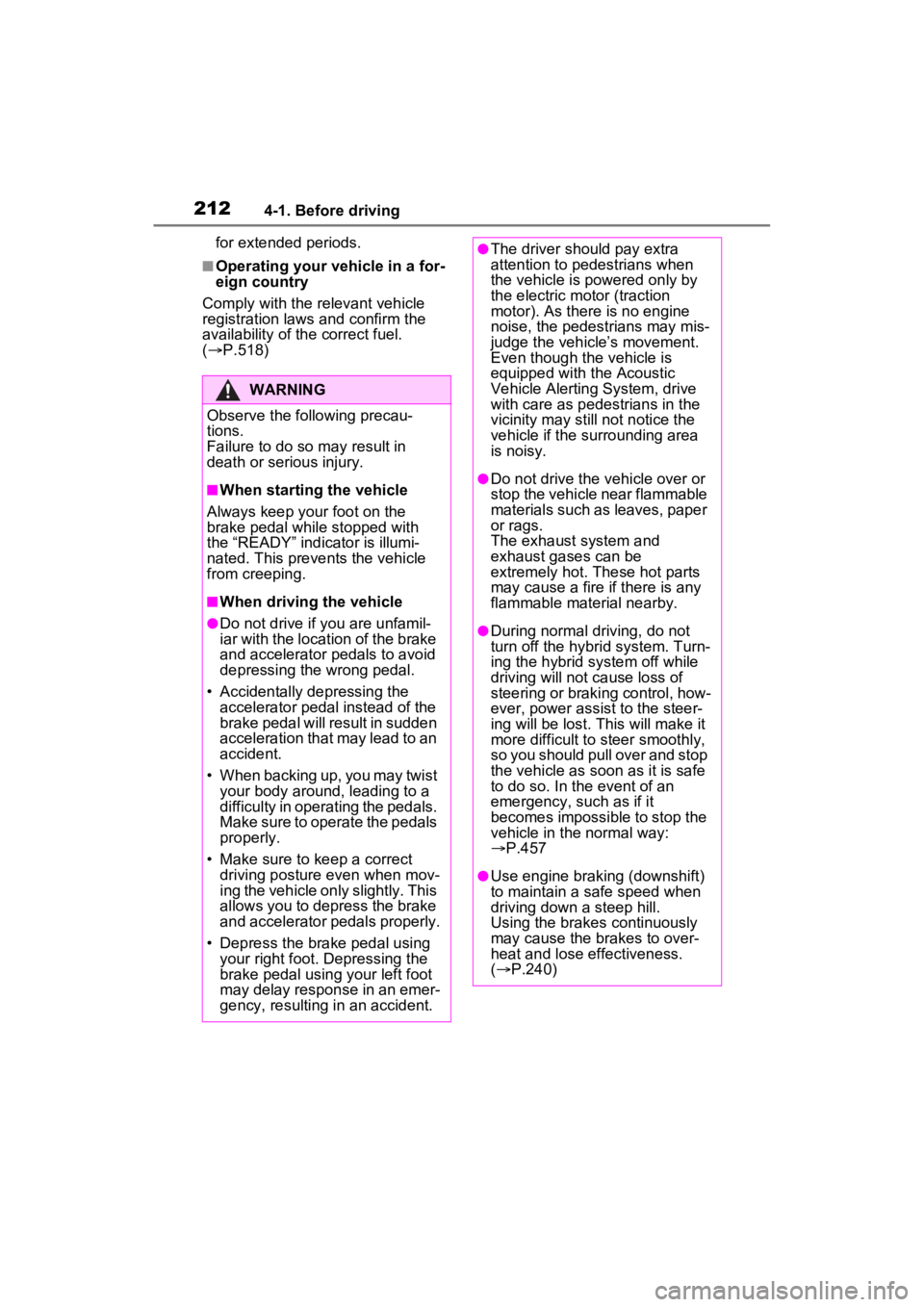
2124-1. Before driving
for extended periods.
■Operating your vehicle in a for-
eign country
Comply with the relevant vehicle
registration laws and confirm the
availability of the correct fuel.
( P.518)
WARNING
Observe the following precau-
tions.
Failure to do so m ay result in
death or serious injury.
■When starting the vehicle
Always keep your foot on the
brake pedal while stopped with
the “READY” indicator is illumi-
nated. This prevents the vehicle
from creeping.
■When driving the vehicle
●Do not drive if y ou are unfamil-
iar with the location of the brake
and accelerator pedals to avoid
depressing the wrong pedal.
• Accidentally depressing the accelerator pedal instead of the
brake pedal will result in sudden
acceleration that may lead to an
accident.
• When backing up, you may twist your body around, leading to a
difficulty in operating the pedals.
Make sure to operate the pedals
properly.
• Make sure to keep a correct driving posture even when mov-
ing the vehicle only slightly. This
allows you to depress the brake
and accelerator pedals properly.
• Depress the brake pedal using your right foot. Depressing the
brake pedal using your left foot
may delay respon se in an emer-
gency, resulting in an accident.
●The driver should pay extra
attention to pedestrians when
the vehicle is powered only by
the electric motor (traction
motor). As there is no engine
noise, the pedestrians may mis-
judge the vehicle’s movement.
Even though the vehicle is
equipped with the Acoustic
Vehicle Alerting System, drive
with care as pedestrians in the
vicinity may still not notice the
vehicle if the surrounding area
is noisy.
●Do not drive the vehicle over or
stop the vehicle near flammable
materials such as leaves, paper
or rags.
The exhaust system and
exhaust gases can be
extremely hot. These hot parts
may cause a fire i f there is any
flammable material nearby.
●During normal driving, do not
turn off the hybrid system. Turn-
ing the hybrid s ystem off while
driving will not cause loss of
steering or braking control, how-
ever, power assist to the steer-
ing will be lost. This will make it
more difficult to steer smoothly,
so you should pull over and stop
the vehicle as soon as it is safe
to do so. In the event of an
emergency, such as if it
becomes impossible to stop the
vehicle in the normal way:
P.457
●Use engine braking (downshift)
to maintain a safe speed when
driving down a steep hill.
Using the brakes continuously
may cause the brakes to over-
heat and lose effectiveness.
( P.240)
Page 214 of 600
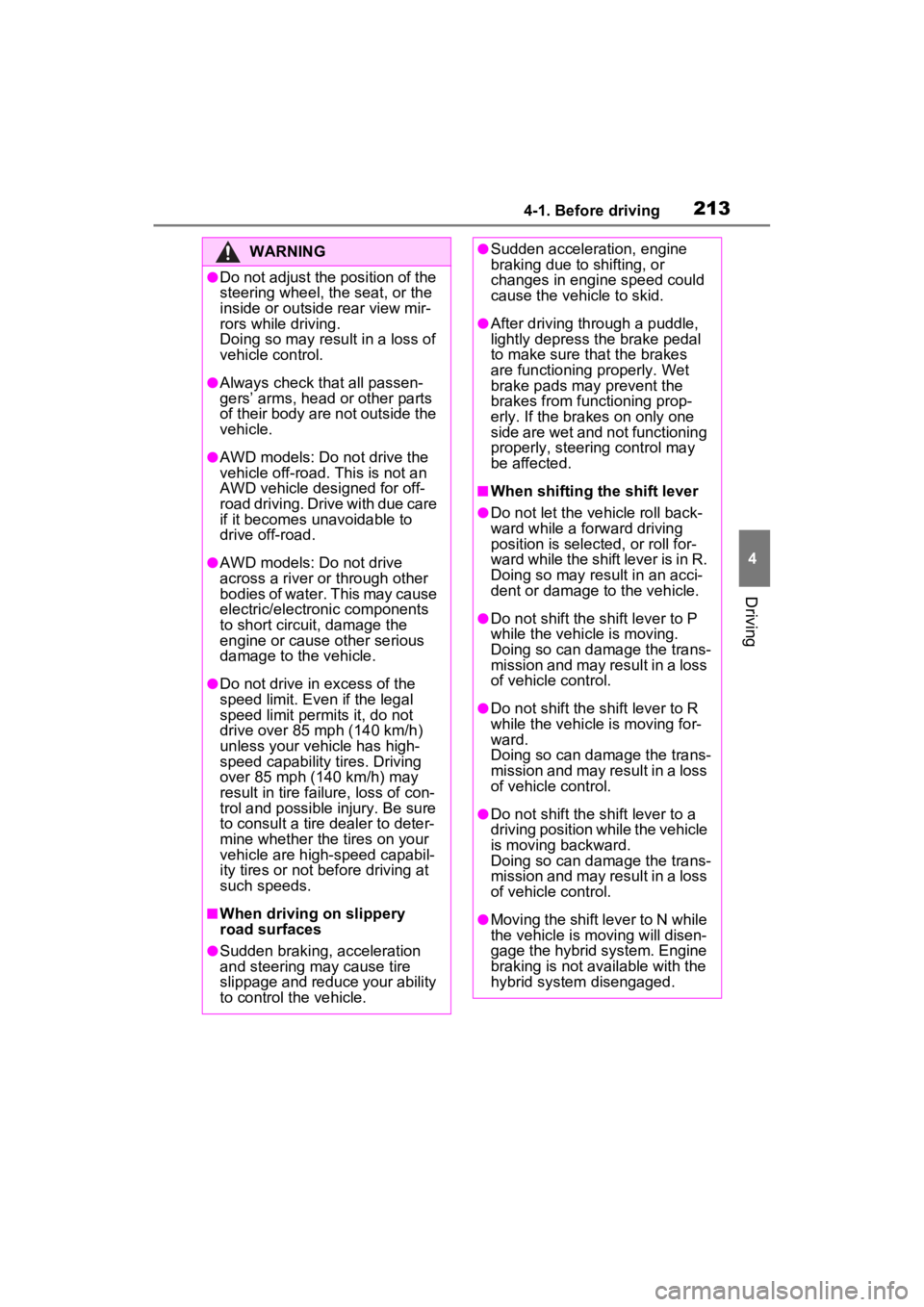
2134-1. Before driving
4
Driving
WARNING
●Do not adjust the position of the
steering wheel, the seat, or the
inside or outside rear view mir-
rors while driving.
Doing so may result in a loss of
vehicle control.
●Always check that all passen-
gers’ arms, head or other parts
of their body are not outside the
vehicle.
●AWD models: Do not drive the
vehicle off-road. This is not an
AWD vehicle designed for off-
road driving. Drive with due care
if it becomes unavoidable to
drive off-road.
●AWD models: Do not drive
across a river or through other
bodies of water. This may cause
electric/electronic components
to short circuit, damage the
engine or cause other serious
damage to the vehicle.
●Do not drive in excess of the
speed limit. Even if the legal
speed limit permits it, do not
drive over 85 mph (140 km/h)
unless your vehicle has high-
speed capability tires. Driving
over 85 mph (140 km/h) may
result in tire failure, loss of con-
trol and possible injury. Be sure
to consult a tire dealer to deter-
mine whether the tires on your
vehicle are high-speed capabil-
ity tires or not b efore driving at
such speeds.
■When driving on slippery
road surfaces
●Sudden braking, acceleration
and steering may cause tire
slippage and reduce your ability
to control the vehicle.
●Sudden acceleration, engine
braking due to shifting, or
changes in engine speed could
cause the vehicle to skid.
●After driving through a puddle,
lightly depress the brake pedal
to make sure that the brakes
are functioning properly. Wet
brake pads may prevent the
brakes from functioning prop-
erly. If the brakes on only one
side are wet and not functioning
properly, steering control may
be affected.
■When shifting the shift lever
●Do not let the vehicle roll back-
ward while a fo rward driving
position is selected, or roll for-
ward while the shift lever is in R.
Doing so may result in an acci-
dent or damage to the vehicle.
●Do not shift the shift lever to P
while the vehicle is moving.
Doing so can damage the trans-
mission and may result in a loss
of vehicle control.
●Do not shift the sh ift lever to R
while the vehicle is moving for-
ward.
Doing so can damage the trans-
mission and may result in a loss
of vehicle control.
●Do not shift the shift lever to a
driving position while the vehicle
is moving backward.
Doing so can damage the trans-
mission and may result in a loss
of vehicle control.
●Moving the shift lever to N while
the vehicle is moving will disen-
gage the hybrid system. Engine
braking is not a vailable with the
hybrid system disengaged.